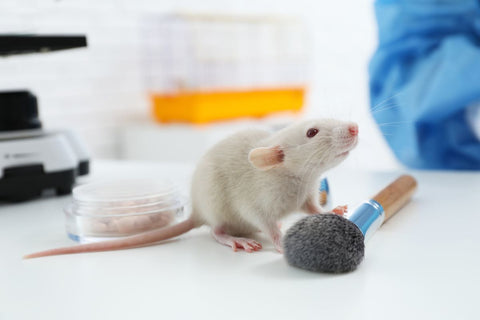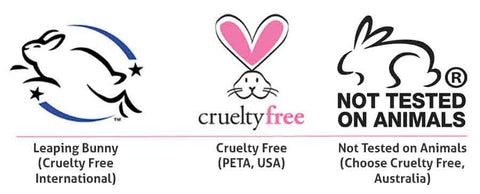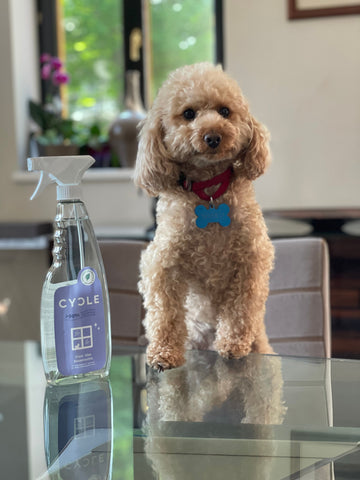You may have seen the bunny symbol on the CYCLE packaging, which stands for Leaping Bunny. This trademark certifies that our products, and many other companies and brands, are cruelty-free.
In this article, we will explain in more detail why this initiative is important, what motivations and goals lie behind the trademark, and how you can recognize and filter such products.
Where did the cruelty free initiative come from?
The term cruelty-free itself is associated with the name of animal rights activist Lady Dowding, who convinced manufacturers of faux fur to use the label “Beauty without cruelty” on their products. In 1959, she founded a charity of the same name to raise awareness of animal suffering in the fashion industry. Lady Dowding used her prominent social position to promote animal welfare. She held regular Sunday lunch parties where she introduced influential people to vegetarian food, and her house was a shelter for animals in need. She also won several awards from the Royal Society for the Prevention of Cruelty to Animals (RSPCA).
However, there are other figures in history who have been associated with the expression and the will to act for animals. Among them, Marcia Pearson popularized this in the United States and founded the group Fashion With Compassion in 1970.
But the roots of the “cruelty-free” movement in the United Kingdom can be traced back to 1898. Cruelty-Free International, an association that is still active today, was founded by philanthropist and women’s rights activist Frances Power-Cobbe. When Power-Cobbe traveled throughout Europe and witnessed first-hand the mistreatment of animals, she started her union, which continued to grow worldwide in the late 19th and early 20th centuries. By 1940, the union had 154 affiliates around the world. Its original name was The British Union for the Abolition of Vivisection, which was changed in 2015 to the now recognizable name Cruelty-Free International .
As the animal testing-free movement has developed, several other credible organizations have emerged, whose collective goal is to promote animal testing- and cruelty-free products and combat animal testing.
People have increasingly come to realize that animal testing is not only cruel but often scientifically unsound. The first country to introduce legislation against animal testing was the United Kingdom in 1998.
The details of the criteria for different labels may vary from country to country among the certification bodies. But in general, to be certified cruelty free, a company must completely eliminate animal testing in the development and production of all its products. This includes testing of ingredients, raw materials, and finished products. Companies that meet these criteria are eligible to use the cruelty free logo on their products.
The cruelty-free movement is not only about protecting animal rights, but also reflects the growing demand for ethical and sustainable shopping. As more companies and consumers join this movement, it is hoped that animal testing will gradually disappear from the testing of cosmetics and household products.
Why are animal rights important?
Although there is ongoing controversy surrounding this issue, it is worth learning the facts and figures, which may encourage consumers to stand up for animals.
A growing body of professional and credible sources is reporting that, just like humans, animals also experience emotional and physical pain. Animals kept in zoos often exhibit behaviors that indicate underlying psychological distress that are not seen in the wild. For example, orcas can suffer from depression and boredom in aquariums, which is treated with antidepressant medications. The more we learn about the myriad ways in which our behavior, lifestyle, and attitudes negatively impact animals, the greater our moral obligation to them will be.
But in addition to the suffering animals can cause, the sheer scale of their exploitation is another reason why animal rights are needed. It is estimated that around 200 million animals are killed every day for human consumption, and the highest per capita meat consumption is in wealthy nations such as Australia, the United States and Europe. The United States is also responsible for the spread of factory farming, where animals are subjected to heartbreaking abuse throughout their lives. The vast majority of animal testing is for military and cosmetic testing, with only a tiny percentage for medical and entertainment research.
Animals used in experiments include baboons, cats, cows, dogs, ferrets, fish, frogs, guinea pigs, hamsters, horses, llamas, mice, monkeys (such as marmots and macaques), owls, pigs, quail, rabbits, rats, and sheep. These animals do not live full lives and usually die after testing.

Manufacturers can experiment on a variety of animals , including mice.
What are the goals of animal testing-free movements?
The ultimate goal of the animal rights movement is to remove animals from human "use," ending exploitative industries and practices, including laboratory testing, whaling, and puppy mills.
There are many approaches to achieving these goals. Grassroots advocacy, including public demonstrations, as well as documentaries and other educational tools, are long-standing methods for raising public awareness of animal suffering and educating people about the concept of animal rights.
There are also innovative legal approaches. For example, the Nonhuman Rights Project is working to change the legal status of nonhuman animals from “property” to “personhood,” with the goal of granting them the right to bodily liberty (no imprisonment) and bodily integrity (no experimentation). A nonhuman person can be represented in court by a legal guardian who can fight for justice on their behalf.
Another way to achieve the goals of the animal rights movement is to support veganism, a lifestyle that excludes the consumption of products derived from animals - including milk, eggs, and insect products such as honey. Veganism also avoids clothing made from animal products, such as leather, fur, and silk. By widely embracing their values, the demand for animal products can be reduced, allowing for a cleaner path to the acceptance of animal rights.
Additionally, producing and purchasing cruelty-free products can be more environmentally sustainable. Non-experimental manufacturing processes are often more efficient and sustainable, which has a positive impact on the environment. Companies that are committed to cruelty-free principles often also seek out animal-friendly and sustainable ingredients, thereby reducing their environmental footprint.
Buying cruelty-free products therefore has many benefits for consumers. On the one hand, it gives us the opportunity to make ethical and responsible decisions in our everyday purchases. On the other hand, by choosing cruelty-free products, we are consciously supporting companies that are committed to animal rights and sustainability.
How are these products tested if not on animals?
Companies that don’t “greenwash” their products can use other, safer options instead of animal testing. This can include anything from researching well-established scientific literature and studies to safety testing of raw materials to controlled human use.
According to Cruelty Free International, alternatives to animal testing include cell cultures, human tissue, computer models, and even human volunteers. Cell cultures allow scientists to grow human or animal cells in the laboratory, creating smaller, 3D versions of human organs, known as "organs-on-a-chip." This method is particularly useful in the field of medicine, as cell cultures have helped scientists better understand diseases such as various cancers, AIDS, and other diseases. These cultures have also proven to be crucial in chemical safety testing.
Scientists can also conduct studies on human tissue - without the need for a living human volunteer. Human volunteers can donate their healthy or unhealthy tissue, and scientists can use it to better understand diseases. Human tissue can be donated by living people - who have undergone surgery, a biopsy or a transplant - or by deceased people. Both are more humane alternatives to animal testing.
Scientists can also learn a lot from computer models programmed to simulate the human body's responses. By mapping major organs, such as the heart and lungs, scientists can conduct virtual experiments based on existing information and mathematical data.
Finally, of course, we can also avoid animal testing by using human volunteers. Various types of technology can be used to measure and observe how the human body responds to certain treatments and drugs. If more human volunteers volunteered for testing, fewer animals would be killed or harmed each year.
How do I know if the product is cruelty free?
There are many ways to help you determine whether a product is cruelty-free or not. Below are some helpful tips on where and how to check:
Logos and inscriptions on packaging
Most cruelty-free products have a label on their packaging. Look for logos like "Cruelty Free," "Not Tested on Animals," or "Leaping Bunny" on the ingredients or information label. These labels are usually easy to recognize and usually feature a bunny. This is a way to be sure that the product is cruelty-free.

Labels from the three major animal testing-free organizations
Source: https://sustainableshopper.com.au/2015/08/25/cruelty-free-logos/
Online databases and applications
There are several online databases and apps available that list cruelty-free brands and products. You can quickly check for a product at any time by visiting the Leaping Bunny website or using the "Bunny Free" app .
Websites of certification organizations
Animal rights organizations that support and certify cruelty-free products often have online databases and guides on companies that do not test on animals. You can also find more information on the websites of PETA or Cruelty Free International .
Company contact pages
If you are unsure about whether a product is cruelty-free, check out the organization's official website for information or contact them directly. These companies are often open to consumer questions and are happy to share their cruelty-free policies.
Customer reviews, forums
Online customer reviews and forums can also be a useful resource. Many consumers share their experiences with cruelty-free products, which can help you make sure that a particular product meets your expectations.
What trademarks do we distinguish today?
Animal-free standards have come a long way since the 19th and 20th centuries, and now there are several certifications. We would like to introduce three main brands:
Beauty Without Bunnies
Beauty Without Bunnies is a cruelty-free certification project by PETA . The organization is based in the United States, but any company from any country can join the project as long as they meet the criteria.
The logo is easily recognizable, depicting a bunny face with big pink ears. You may come across other variations, but most of them feature this design.
Leaping Bunny
Next up is the Leaping Bunny. This is the logo for the organization I mentioned earlier, Cruelty-Free International. They're a worldwide organization.
The Leaping Bunny trademark, which is also featured on our packaging, is a jumping bunny. You've probably seen this logo on many cosmetic products, as it is considered the number one cruelty-free trademark.
Choose Cruelty Free
Finally, there is the Choose Cruelty Free logo. This certification body operates exclusively in Australia and only deals with companies that sell products in the Australian market.
The logo is an outline of a bunny, with the words "Not tested on animals" written in bold letters underneath.
The cruelty-free logo or label helps consumers choose products that are free from animal testing. Thus, this marking on the packaging is a form of information that helps consumers make an informed decision.
Are vegan products free from animal testing?
Finally, it's worth dispelling a misconception that vegan products are also free from animal testing.
Cruelty-free refers to products that have not been tested on animals, while vegan refers to products that do not contain any animal-derived ingredients. It is possible that a product labeled cruelty-free may still contain non-vegan ingredients such as milk protein, beeswax, carmine, collagen, gelatin, or lanolin.
If you want to use only vegan and cruelty-free products, look for products that have both on the label. And to be on the safe side, check the ingredients for the non-vegan ingredients mentioned above.
You can read more about this on veganinja.hu, here .
CYCLE and cruelty-free
We were the first in Hungary to receive the Leaping Bunny trademark in the household products category. The trademark of this internationally recognized standard has been displayed in a prominent place on all our products since September 24, 2020. This way, you can be sure that you are not only using a toxin-free cleaning product, but also one that is cruelty-free.

Thanks to our chemical-free products, every pet can spend their days happily in our home.
This certification is not just a label on our products: with our cleaning products we want to create a community that cares about our planet and the living creatures that live on it. The fight against animal testing is increasingly becoming part of consumer awareness, and we are proud to help our customers do this. At the same time, we want to emphasize not only our ethical principles, but also serve as inspiration for other local brands.
To read more about how we received this trademark, click here .
Sources used for this article:
https://www.humanesociety.org/resources/animals-used-experiments-faq#many
https://faunalytics.org/the-animal-rights-movement-history-and-facts-about-animal-rights/




